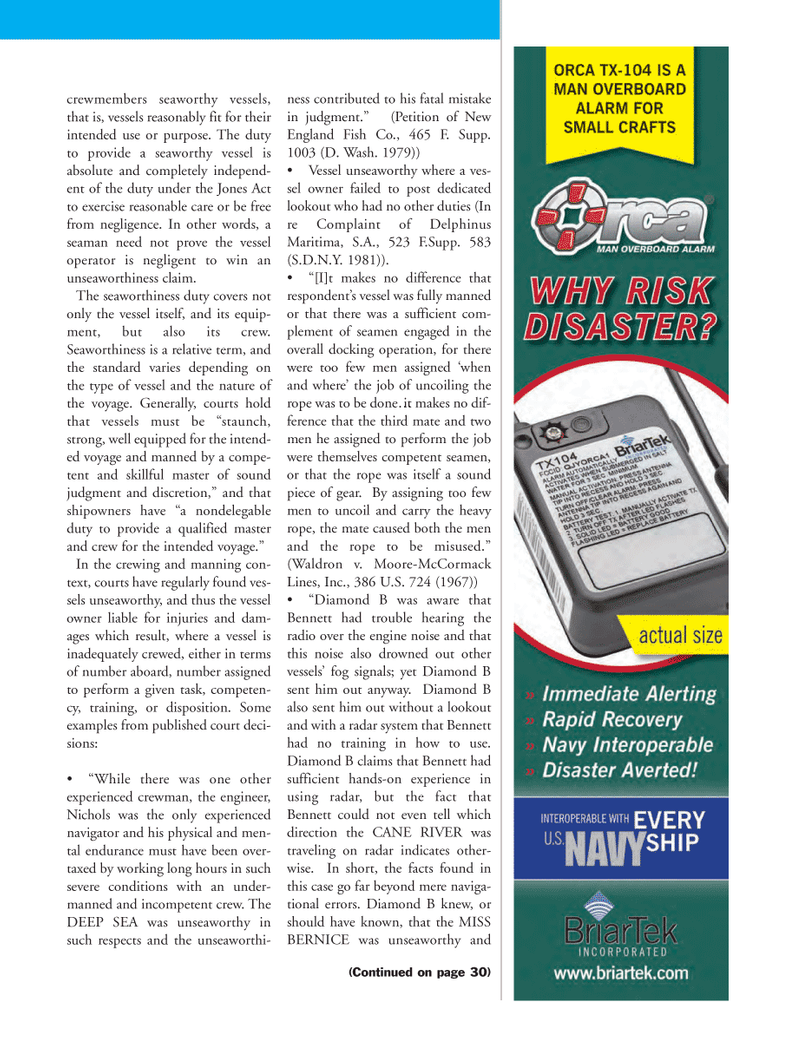
Page 27: of Marine News Magazine (March 2012)
Training & Education
Read this page in Pdf, Flash or Html5 edition of March 2012 Marine News Magazine
crewmembers seaworthy vessels, that is, vessels reasonably fit for their intended use or purpose. The duty to provide a seaworthy vessel is absolute and completely independ-ent of the duty under the Jones Act to exercise reasonable care or be free from negligence. In other words, a seaman need not prove the vessel operator is negligent to win anunseaworthiness claim. The seaworthiness duty covers not only the vessel itself, and its equip- ment, but also its crew. Seaworthiness is a relative term, and the standard varies depending on the type of vessel and the nature of the voyage. Generally, courts hold that vessels must be ?staunch, strong, well equipped for the intend- ed voyage and manned by a compe- tent and skillful master of soundjudgment and discretion,? and that shipowners have ?a nondelegable duty to provide a qualified master and crew for the intended voyage.? In the crewing and manning con- text, courts have regularly found ves- sels unseaworthy, and thus the vessel owner liable for injuries and dam- ages which result, where a vessel is inadequately crewed, either in terms of number aboard, number assigned to perform a given task, competen- cy, training, or disposition. Some examples from published court deci- sions:?While there was one other experienced crewman, the engineer, Nichols was the only experienced navigator and his physical and men-tal endurance must have been over- taxed by working long hours in such severe conditions with an under- manned and incompetent crew. The DEEP SEA was unseaworthy in such respects and the unseaworthi- ness contributed to his fatal mistakein judgment.? (Petition of New England Fish Co., 465 F. Supp. 1003 (D. Wash. 1979)) Vessel unseaworthy where a ves- sel owner failed to post dedicated lookout who had no other duties (In re Complaint of Delphinus Maritima, S.A., 523 F.Supp. 583 (S.D.N.Y. 1981)). ?[I]t makes no difference that respondent?s vessel was fully manned or that there was a sufficient com- plement of seamen engaged in theoverall docking operation, for there were too few men assigned ?when and where? the job of uncoiling the rope was to be done?it makes no dif- ference that the third mate and two men he assigned to perform the job were themselves competent seamen, or that the rope was itself a sound piece of gear. By assigning too few men to uncoil and carry the heavy rope, the mate caused both the men and the rope to be misused.? (Waldron v. Moore-McCormack Lines, Inc., 386 U.S. 724 (1967)) ?Diamond B was aware that Bennett had trouble hearing the radio over the engine noise and that this noise also drowned out other vessels? fog signals; yet Diamond B sent him out anyway. Diamond B also sent him out without a lookoutand with a radar system that Bennett had no training in how to use. Diamond B claims that Bennett had sufficient hands-on experience inusing radar, but the fact that Bennett could not even tell which direction the CANE RIVER was traveling on radar indicates other- wise. In short, the facts found in this case go far beyond mere naviga- tional errors. Diamond B knew, or should have known, that the MISS BERNICE was unseaworthy and (Continued on page 30)MN#3 (18-31):MN 2011 Layouts 3/2/2012 9:49 AM Page 27

 26
26

 28
28
